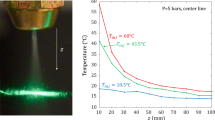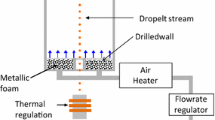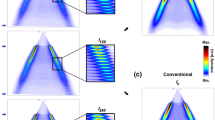Abstract
Droplets temperature is a key parameter for the study of heat and mass transfers in many spray applications. Time correlated single photons counting (TCSPC) is applied to monitor the fluorescence decay and determine the droplet temperature in the mixing zone of two sprays which are injected with significantly different temperatures. For some well-chosen fluorescent dye, like rhodamine B (RhB), the fluorescence lifetime strongly varies with the temperature. Provided sufficiently different fluorescence lifetimes for the droplets of the two sprays, the fluorescence decay is expected to follow a multiple exponential decay. In this study, different approaches are tested for measuring the temperature of the two sprays as well as their mixing fraction based on the analysis of the fluorescence decay. Firstly, the measurement of the mixture fraction alone is tested by considering a configuration where one spray is seeded with eosin Y (EY) and the other with rhodamine 6G (Rh6G). Given the very different lifetimes of these dyes, which are not temperature dependent, the fluorescence decay is function of the volume fraction of liquid from each spray in these tests. A calibration is necessary to evaluate the mixing fraction. Both sprays are mounted on an automated platform allowing 3D scanning and motions which allows obtaining maps of the fluorescence decay. The out-of-field fluorescence, observed in dense sprays when fluorescence is induced by one-photon absorption, is suppressed by using a two-photon fluorescence excitation. This approach significantly improves the spatial resolution of the measurements. Finally, both the droplet temperature and the mixing fraction are measured simultaneously using a single dye, namely RhB, whose fluorescence lifetime is temperature dependent. Special care must be paid to the fact that RhB does not have a purely monoexponential decay at a given temperature. The fluorescence decay in the mixing zone of the two sprays is considered as a combination of two biexponentials. Results show that the volume fraction of a spray must exceed about 10% to make it possible to determine its temperature with an accuracy of about 2–3 °C. Simultaneous measurements of the sprays temperatures and volume fractions provide a means to calculate the mixing temperature (the average between the temperatures of the two sprays weighted by their volume fractions).
Graphical abstract


















Similar content being viewed by others
References
Bachalo WD, Houser MJ (1984) Phase/Doppler Spray analyzer for simultaneous measurements of drop size and velocity distributions. Opt Eng. https://doi.org/10.1117/12.7973341
Berrocal E, Conrad C, Püls J, Arnold L, Wensing M, Linne M, Miranda M (2019) Two-photon fluorescence laser sheet imaging for high contrast visualization of atomizing sprays. OSA Continuum. https://doi.org/10.1364/OSAC.2.000983
Boens N, Qin W, Basarić N et al (2007) Fluorescence lifetime standards for time and frequency domain fluorescence spectroscopy. Anal Chem. https://doi.org/10.1021/ac062160k
Carns JC, Moncivais G, Brock JR (1990) Time-resolved raman spectroscopy from reacting optically levitated microdroplets. Appli Opt 29:2913–2918
Casadevall I Solvas X, Srisa-Art M, De Mello AJ, Edel JB (2010) Mapping of fluidic mixing in microdroplets with 1 μs time resolution using fluorescence lifetime imaging. Anal Chem 82:3950–3956. https://doi.org/10.1021/ac100055g
Chaze W, Caballina O, Castanet G, Lemoine F (2016) The saturation of the fluorescence and its consequences for laser-induced fluorescence thermometry in liquid flows. Exp Fluids 57:1–18. https://doi.org/10.1007/s00348-016-2142-8
Chaze W, Caballina O, Castanet G, Lemoine F (2017) Spatially and temporally resolved measurements of the temperature inside droplets impinging on a hot solid surface. Exp Fluids. https://doi.org/10.1007/s00348-017-2375-1
Coppeta J, Rogers C (1998) Dual emission laser induced fluorescence for direct planar scalar behavior measurements. Exp Fluids. https://doi.org/10.1007/s003480050202
Domann R, Hardalupas Y (2003) Quantitative measurement of planar droplet Sauter mean diameter in sprays using planar droplet sizing. Part Part Syst Charact 20:209–218. https://doi.org/10.1002/ppsc.200390027
Kristoffersen AS, Erga SR, Hamre B, Frette Ø (2014) Testing fluorescence lifetime standards using two-photon excitation and time-domain instrumentation: rhodamine B, coumarin 6 and lucifer yellow. J Fluoresc. https://doi.org/10.1007/s10895-014-1368-1
Labergue A, Deprédurand V, Delconte A et al (2010) New insight into two-color LIF thermometry applied to temperature measurements of droplets. Exp Fluids 49:547–556. https://doi.org/10.1007/s00348-010-0828-x
Labergue A, Delconte A, Castanet G, Lemoine F (2012) Study of the droplet size effect coupled with the laser light scattering in sprays for two-color LIF thermometry measurements. Exp Fluids 52:1121–1132. https://doi.org/10.1007/s00348-011-1242-8
Labergue A, Delconte A, Lemoine F (2013) Study of the thermal mixing between two non-isothermal sprays using combined three-color LIF thermometry and phase Doppler analyzer. Exp Fluids. https://doi.org/10.1007/s00348-013-1527-1
Lakowicz JR (ed) (2006) Principles of fluorescence spectroscopy. Springer US, Boston. https://doi.org/10.1007/978-0-387-46312-4
Lemoine F, Castanet G (2013) Temperature and chemical composition of droplets by optical measurement techniques: a state-of-the-art review. Exp Fluids 54:1572. https://doi.org/10.1007/s00348-013-1572-9
Mendels DA, Graham EM, Magennis SW et al (2008) Quantitative comparison of thermal and solutal transport in a T-mixer by FLIM and CFD. Microfluid Nanofluid. https://doi.org/10.1007/s10404-008-0269-5
Mercadé-Prieto R, Rodriguez-Rivera L, Chen XD (2017) Fluorescence lifetime of Rhodamine B in aqueous solutions of polysaccharides and proteins as a function of viscosity and temperature. Photochem Photobiol Sci. https://doi.org/10.1039/c7pp00330g
Müller T, Grünefeld G, Beushausen V (2000) High-precision measurement of the temperature of methanol and ethanol droplets using spontaneous Raman scattering. Appl Phys B 70:155–158
Perrin L, Castanet G, Lemoine F (2015) Characterization of the evaporation of interacting droplets using combined optical techniques. Exp Fluids 56:1–16. https://doi.org/10.1039/c6cs00902f
Schweiger G (1990) Raman scattering on single aerosol particles and on flowing aerosols: a review. J Aerosol Sci 21:483–509
Stiti M, Labergue A, Lemoine F et al (2019) Temperature measurement and state determination of supercooled droplets using laser-induced fluorescence. Exp Fluids 60:1–13. https://doi.org/10.1007/s00348-018-2672-3
Stiti M, Labergue A, Hervy F et al (2021a) Characterization of supercooled droplets in an icing wind tunnel using laser-induced fluorescence. Exp Fluids 62:169
Stiti M, Yangpeng L, Hadrien C et al (2021b) Fluorescence lifetime measurements applied to the characterization of the droplet temperature in sprays. Exp Fluids. https://doi.org/10.1007/s00348-021-03264-x
Strizhak PA, Volkov RS, Antonov DV et al (2020) Application of the laser induced phosphorescence method to the analysis of temperature distribution in heated and evaporating droplets. Int J Heat Mass Transf 163:120421. https://doi.org/10.1016/j.ijheatmasstransfer.2020.120421
Ulrich H, Lehnert B, Guénot D, Svendsen K, Lundh O, Wensing M, Berrocal E, Zigan L (2022) Effects of liquid properties on atomization and spray characteristics studied by planar two-photon fluorescence. Phys Fluids 34: https://doi.org/10.1063/5.0098922
van Beeck JPAJ, Giannoulis D, Zimmer L, Riethmuller ML (1999) Global rainbow thermometry for droplet-temperature measurement. Opt Lett 24:1696. https://doi.org/10.1364/OL.24.001696
Acknowledgements
The authors are grateful to the China Scholarship Council (CSC) for the scholarship attributed to Mr. M. Wang, who was hosted by LEMTA at Université de Lorraine, France. The authors also gratefully acknowledge the financial support of the ENERBATIN CPER program and the European FEDER program.
Author information
Authors and Affiliations
Contributions
WM performed the measurements; SM and CG were involved in planning and supervised the work. CH and BS were involved in the implementation of the optical system and the measurement methods. MW, MS and GC processed the experimental data, performed the analysis, drafted the manuscript, and designed the figures. FL and EB provided critical feedback and helped shape the research. GC conceived the original idea and was in charge of overall direction of the project. All authors discussed the results and commented on the manuscript.
Corresponding author
Additional information
Publisher's Note
Springer Nature remains neutral with regard to jurisdictional claims in published maps and institutional affiliations.
Appendix
Appendix
A Monte Carlo method was implemented to estimate the measurement uncertainties. It consists in generating synthetic histograms of the photon arrival times, while taking into account the photon count rate, the acquisition time, the noise level, the IRF, and the time-channel width. Such method has been already employed by Stiti et al. (2021b) for assessing the precision of temperature measurements in a single spray. In this study, a monoexponential function was used to describe the fluorescence decay. Presently, since two sprays are considered, the fluorescence model has been extended to a two-exponential decay to follow the theoretical model presented in Sect. 5.1a. Results obtained with the method are presented hereafter for \({T}_{1}\;\)= 60 °C and \({T}_{2}\)= 20 °C. Two count rates, 2000 Cps and 15000 Cps, are also considered. The count rate of 2000 cps corresponds to the worst-case scenario (no measurements were performed with a lower count rate in the experiments). The count rate of 15,000 cps is a median value among the measurements. For some given values of the volume fraction \(\psi\) and the count rate, more than 2000 synthetic histograms are generated using the Monte Carlo method. These histograms are analyzed the same manner as their experimental counterparts in order to estimate the temperatures \({T}_{1}\) and \({T}_{2}\), the volume fraction \(\psi\), the mixing temperature \({T}_{\mathrm{m}}\) and the LIF temperature \({T}_{\mathrm{LIF}}\). Based on the thousands of generated data, the average and the standard deviation can be calculated for those quantities, which allows to evaluate the uncertainties of their measurements.
Figure
Confidence intervals of the estimations of the volume fraction \(\psi\) and the mixing temperature \({T}_{m}\) when the acquisition time is modified. Each data point is the result of the computation of 2000 synthetic fluorescence decays with the Monte Carlo method. A noise of 28 Cps is considered. The count rate of A and B is 2000 Cps and 15000 Cps for C and D
18 shows the influence of the acquisition time on the estimates of the volume fraction \(\psi\) and the mixing temperature \({T}_{\mathrm{m}}\). The colored areas on the graphs correspond to the confidence intervals of half-width equal to the standard deviations \({\sigma }_{\psi }\) or \({\sigma }_{{T}_{m}}\). It can be observed that an acquisition time of 100 s is a good compromise. It allows having a limited estimation error while maintaining an acceptable acquisition time. This value of the acquisition time was thus retained in the experiments and in the tests performed in the following for evaluating the uncertainties with the Monte Carlo method.
Using the same approach, uncertainties were also quantified for different values of the volume fraction \(\psi\) at a fixed acquisition time of 100 s in Fig.
Evolution of the standard deviation of the estimated temperature of the hot (\({T}_{1}\)) and cols (\({T}_{2}\)), the mixing fraction \((\psi\)), the mixing temperature (\({T}_{\mathrm{m}}\)) and the LIF temperature (\({T}_{\mathrm{LIF}}\)) as a function of the mixing fraction. Each point is the result of 2000 synthetic fluorescence decays using an acquisition time of 100 s, a noise count rate of 28 Cps and in A 2 000 Cps and B 15 000 Cps count rate
19. Significant differences can be observed between \({\sigma }_{{T}_{1}}\) and \({\sigma }_{{T}_{2}}\). These can be explained by the fact that the hot spray has a much shorter fluorescence lifetime than the cold spray (Fig. 7). When \(\psi\) approaches 1, there is very little of the hot spray passing in the measurement volume in comparison with the cold spray. Therefore, the presence of the hot spray is difficult to detect based on the fluorescence decay. Not only it is hardly visible at the long times but also at the short times. So \({\sigma }_{{T}_{1}}\) is large while \({\sigma }_{{T}_{2}}\) is small. When \(\psi\) gets close to 0, the hot spray has a stronger influence on the fluorescence decay especially at the short times, but the cold spray keeps a significant influence at the long times. The uncertainty on the temperature \({T}_{2}\) of the cold spray does not increase that much. The value of \({\sigma }_{{T}_{2}}\) remains smaller than 1 °C for values of \(\psi\) as low as 0.1. Finally, it is interesting to note that the uncertainties on the parameters \({T}_{\mathrm{m}}\) and \({T}_{Lif}\) remain always lower than 1 °C, while the uncertainty on the temperature of the hot spray \(\left({\sigma }_{{T}_{1}}\right)\) reaches several °C. This is due to the fact that the different parameters are correlated, and errors can compensate each other. The error on the volume fraction \(\psi\) remains lower than 1% when the hot spray is predominant in the measurement volume (more precisely for \(\psi\) < 0.4).
Rights and permissions
Springer Nature or its licensor holds exclusive rights to this article under a publishing agreement with the author(s) or other rightsholder(s); author self-archiving of the accepted manuscript version of this article is solely governed by the terms of such publishing agreement and applicable law.
About this article
Cite this article
Wang, M., Stiti, M., Chaynes, H. et al. Two-photon fluorescence lifetime imaging applied to the mixing of two non-isothermal sprays: temperature and mixing fraction measurements. Exp Fluids 63, 172 (2022). https://doi.org/10.1007/s00348-022-03515-5
Received:
Revised:
Accepted:
Published:
DOI: https://doi.org/10.1007/s00348-022-03515-5






